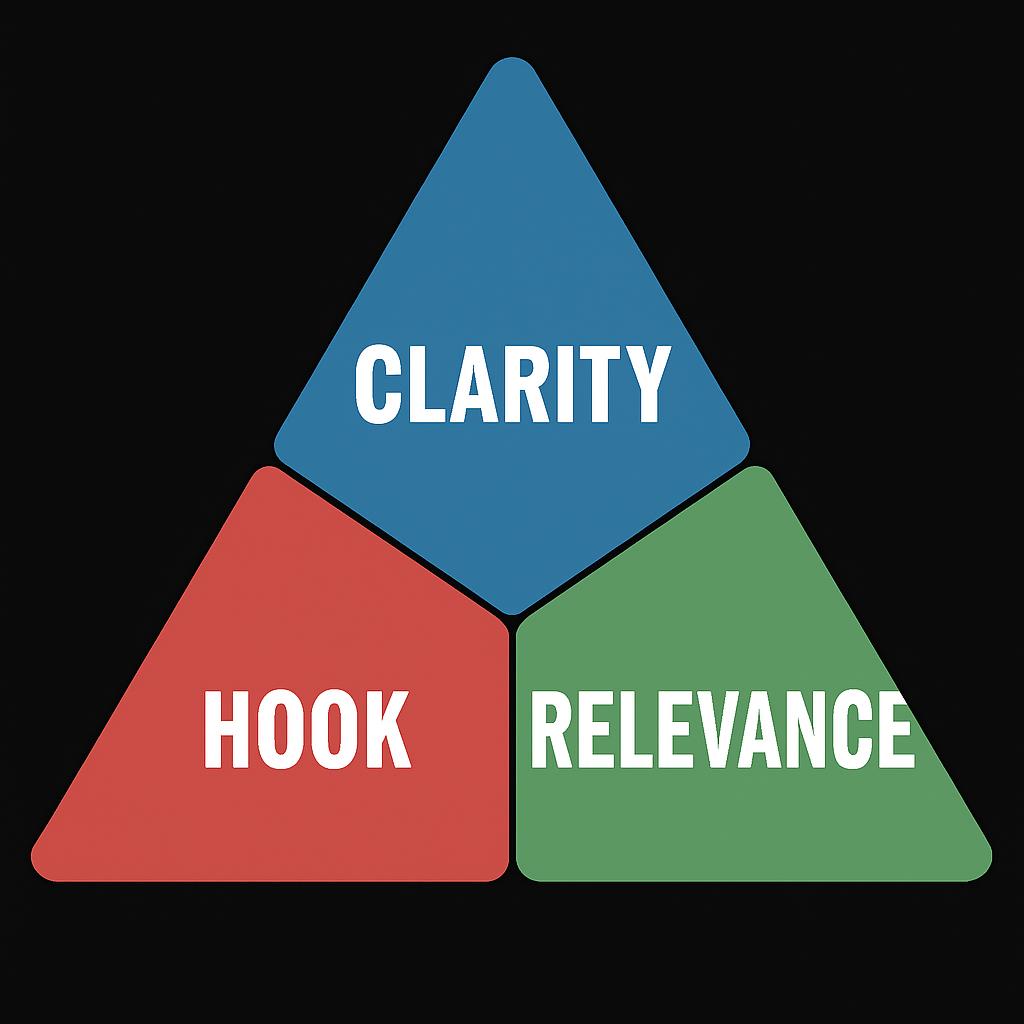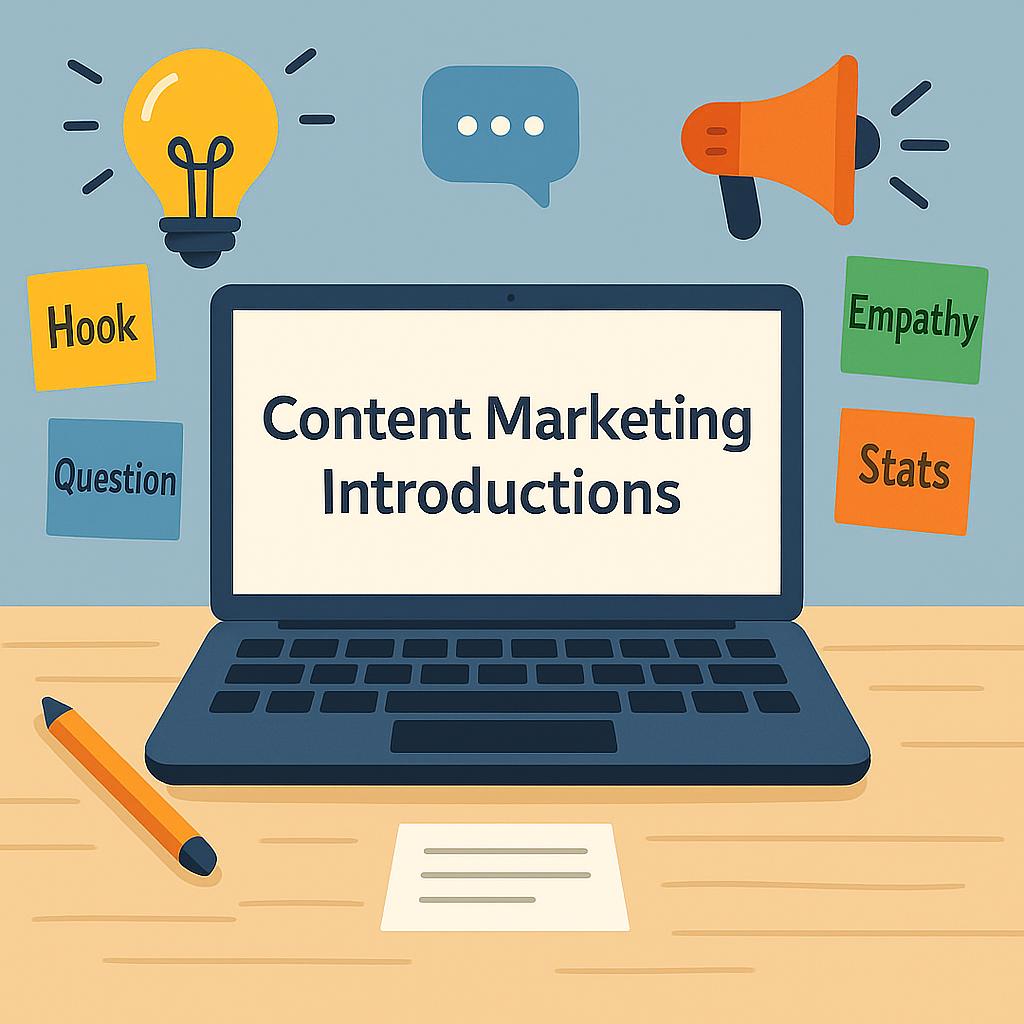Your introduction decides if anyone reads the next line.
In content marketing introductions, you have only a few seconds to prove you are worth the scroll. Since attention is scarce, your first sentence should set context, signal value, and hint at a payoff.
Do that with clear promises and engaging content openings.
In this guide, you’ll find simple tips plus good and bad examples to show what works (and what to avoid). Apply our introduction writing tips, and you’ll see that even small changes to article opening lines can lift time-on-page and conversions.
What Makes an Effective Introduction
An effective intro gives readers confidence that they are in the right place. It shows you understand their problem, and it points to a practical outcome. It also earns the next click inside your site.
A clear blog post structure sets expectations, places the hook early, and guides the reader. Moreover, readers skim, so you need scannable cues near the top where eyes focus first.
Research on web reading shows people decide quickly and often scan in an F pattern, which puts extra pressure on your first two paragraphs.
Key Elements: Clarity, Hook, and Relevance.
- Clarity: State the problem or promise in plain language. Avoid hedging.
- Hook: Use a sharp content hook that sparks curiosity without overhyping.
- Relevance: Tie the topic to a pain, goal, or job-to-be-done your audience cares about.
Additionally, keep sentences short and front-load keywords. For SEO, you still must sound natural. And for trust, avoid vague claims.
Example:
You spend hours on content, yet readers bounce before paragraph two. In the next three minutes, you will learn a simple process to write introductions that win attention and set expectations. By the end, you will know how to craft article opening lines that earn the click.
Why Some Content Marketing Introductions Fail
Weak openings are easy to spot. They are generic, slow, or misaligned with search intent. As a result, readers bail quickly, and most of that loss happens early.
Public data suggests many visitors spend under 15 seconds on a page, so the margin for error is small.
Generic or Vague Openings
Example:
“Marketing is important for every business. In today’s fast-paced world, companies need to stand out. This article will discuss several tips”.
If your intro could sit on any site, it helps no one. Generic claims drain energy and undermine authority. Instead, you need specifics that show you get the reader’s world.
(For help writing non-generic copy, study methods for writing original, non-generic content).
Vague language hides your value. Readers want to know what they will learn and why it matters now. They will not wait.
Fluff That Wastes the Reader’s Time
Example:
“In today’s modern marketing age, content remains king, and we must pay close attention to how we begin our articles. The introduction is a vital component that can play an important role in success”.
Fluff is any sentence that adds words but not meaning. It slows comprehension and signals you are not respecting the reader’s task. Consequently, people skim faster or exit.
Trim throat-clearing phrases like “In today’s digital age” or “It is important to note.” Keep momentum high so readers move from the hook to the proof.
Fix it by cutting dead weight. Then rewrite with focus and action. You can use these tips to shorten sentences without losing meaning.
Ignoring Audience Intent
Example:
“Our company has been a leader in CRM solutions for years. With a wide range of features and a commitment to customer success, we help organizations of all sizes achieve their goals. This article will discuss some aspects of CRM software”.
When an intro misses intent, it feels off-key. The reader came with a job to do, and your opening should mirror that language and outcome. Otherwise, they conclude the page is irrelevant.
Align your promise with the query type: informational, transactional, or navigational. Then keep your focus narrow.
Techniques for Writing Engaging Introductions
Good intros are teachable. You can combine a hook with proof, and then bridge to your key sections. Start with what matters most. Then deliver a credible reason to keep reading.
Here is a simple sequence you can reuse:
- Name the problem.
- Show stakes or payoff.
- Prove credibility with a fact, example, or insight.
- Preview the solution.
After that, transition into your first H2.
Storytelling and Curiosity
Story pulls readers in because it feels concrete. Curiosity keeps them moving because they want resolution. But, it’s important to keep anecdotes tight and relevant.
You can imply a story in two lines, then pivot to the takeaway. Review these practical advices on storytelling in content marketing.
Example:
“Yesterday your webinar sign-up page sat at 1.2% conversion. Today it is at 3.9% after a 12-word tweak to the first sentence. In this walkthrough, you will see the exact change, the A/B results, and how to adapt it to your page”.
Using Stats, Questions, or Empathy
Data calms skeptics, while smart questions wake up a tired reader. Empathy tells your audience you understand their world.
You do not need all three in one intro, but one strong move helps.
- Ask a question that names the pain.
- Share a statistic that reframes effort or potential.
- Show empathy by reflecting the reader’s constraints.
B2B marketers rate videos and case studies as highly effective formats, yet short articles still carry heavy usage. That mix can shape which intro you choose and what you promise.
Example:
“How many hours did you spend on last month’s blog post, only to watch average engaged time sit under 30 seconds? This guide gives you three repeatable ways to write engaging content openings that hold attention and set up a clear, useful outcome”.
Matching Intro Style to Content Goals
Your opening should fit the page’s job, not your habit. A how-to needs a quick promise and scope: a product page intro should clarify next steps.
In addition, remember the primacy effect. People recall the first items best, so front-load value in your opening lines and subheads. That simple shift helps comprehension and recall.
For SEO balance, plan your keywords, then edit for SEO without killing flow.
Intro style fit at a glance:
| Goal | Recommended intro style | Keep in mind |
|---|---|---|
| How-to | Problem → payoff → quick steps | Promise a specific outcome and timeframe |
| Thought leadership | Contrarian insight → context → evidence | Avoid hype; deliver a fresh, testable idea |
| Case study | Situation → challenge → result snapshot | Include a hard number early |
| Product page | Pain → proof → action | Remove uncertainty and offer the next step |
Example:
“You want a faster way to qualify leads without adding forms. This tutorial shows how to reduce friction on your demo page with one experiment and a simple routing rule. In 10 minutes, you will ship A/B tests that you can run today”.
Summary
Content marketing introductions are crucial because they determine if readers will continue engaging with your content.
To be effective, your introduction must quickly set context, offer clear value, and motivate readers to keep going.
Don’t use generic, vague, or fluffy openings, as these lose attention fast and do not address reader intent. Instead, use strong content hooks, clarity, and relevance. Techniques like storytelling, impactful statistics, and empathy make blog post introductions better.
Match your intro style to the content’s purpose and always front-load the main value for both SEO and reader interest.
Frequently Asked Questions
Q1: How long should an introduction be?
Aim for 80 to 150 words. Shorter intros work when your audience already knows the topic. Longer intros can work when you must define terms or set stakes. Nevertheless, keep the first sentence in marketing content direct and useful.
Q2: What is a simple formula for writing effective introductions?
Try this: Problem → Stakes → Proof → Preview. First, name the specific pain. Next, show why acting now matters. Then give a quick proof point. Finally, preview the solution. This sequence creates natural content hooks without tricks.
Q3: Are questions a good way to start?
Yes, when the question mirrors the reader’s intent. However, avoid vague questions that anyone could ask. Tie the question to a measurable outcome and follow with a clear point, not with filler.
Q4: How do I make marketing copy introductions feel less salesy?
Lead with value. Use concrete language. Also, offer one fast win before you ask for anything. If you must mention your product, do it through a relevant use case that proves the benefit.
Q5: What mistakes should I avoid in blog post introductions?
Watch for generic claims, long wind-ups, and missing context. In addition, avoid empty adjectives and passive voice. Finally, steer clear of bait-and-switch hooks that overpromise and underdeliver.



